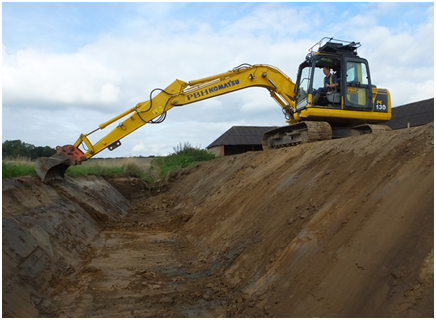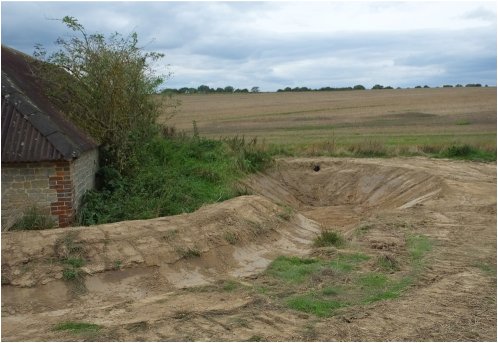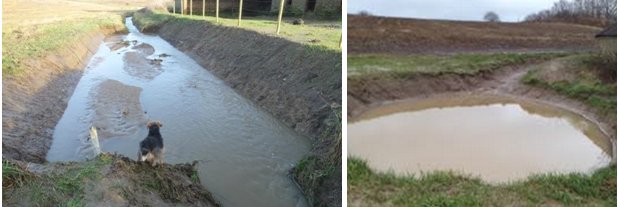Project Objectives
The Environment Agency (EA) has funded a diffuse pollution project currently being delivered by the Arun & Rother Rivers Trust (ARRT) looking into the effectiveness and practicalities of sediment traps as a means of reducing sediment runoff into the Western Rother catchment. Specifically, this project focusses upon sediment traps located within existing drainage ditches linked to the River Rother. The benefit of such an approach over ‘in-field’ sediment traps is that they catch a wider area of potential runoff and are not limited by crop type which can vary from year to year (e.g. silt traps are known to be effective in fields sown with salad crops, maize or potatoes but will be significantly less effective if other crops are sown).
A key EA remit for undertaking this project was to encourage working with external partners and landowners to reduce soil/water runoff to the Western Rother which in turn will help improve water quality and the biodiversity of riverine habitats, in addition to helping to preserve topsoil as an important farming and natural resource in its own right. Reducing sediment input into the Rother catchment will contribute towards achieving Good Ecological Status for the river, as required under the EU Water Framework Directive (WFD) which legally binds the UK Government to improve the ecological quality and robustness of its rivers.
The impact of land use on surface water runoff production is thought to be a contributing factor to the poor ecological status of parts of the Western Rother. The impact of diffuse pollution upon the water environment is a significant issue for the Arun & Rother catchment. Agriculture is not the sole cause of diffuse pollution but at a national level it does contribute to approximately 60% of nitrates, 25% of phosphorus and 70% of sediments entering our watercourses (Defra website www.defra.gov.uk). There is national and European legislation in force that aims to prevent any further deterioration in water quality, and to protect and enhance the ecological status of all rivers, lakes, groundwaters, estuaries and coastal waters. This project complements recent research into Rural Sustainable Drainage Systems (rSuDS), which in itself is not a new concept but is not widespread in the rural environment and could present many opportunities for improving the management and quality of water at (or closer to) its natural source.
There are many different types of sediment traps that together represent a variety of physical structures that can be used to mimic natural processes, such as slowing down runoff velocity and catching and settling finer sediments held in suspension. In rural environments, sediment traps are an approach for managing the detrimental impact of rainfall on fields where run-off poses a potentially significant pressure upon local flora, fauna and the chemical status of nearby surface waters.
Project Deliverables
The ARRT has kindly been assisted in their work by the Leconfield Estate and Langmead Farms Limited in identifying a number of potential sites for sediment traps on agricultural land that is relatively close to the Western Rother just South of Petworth.
In October 2013 two sediment traps at Crows Hole Barn where constructed, both directly linked to a ditch that drains the surrounding agricultural land before discharging into the main Western Rother channel approximately 500m away. Their design was developed with the assistance of river engineering contractors Wessex Land & Water (now Aquascience Ltd.) and delivered by Amenity Water Management Ltd., a local appropriately skilled contractor.
In addition to constructing the sediment traps the ARRT are committed to maintaining and clearing out the traps over a period of three years, and aim to quantify and assess the runoff that is collected. Good relationships between local farmers, landowners and the ARRT are essential for this important project to be able to succeed. This project is also supported by the local EA Fisheries & Biodiversity officer, the local Catchment Sensitive Farming (CSF) officer and is being further augmented by establishing links with relevant academia that have long-standing research programmes focussed upon land-use and erosion in the Rother valley, in particular Professor John Boardman of Oxford University and Professor Ian Foster of the University of Northampton. The photograph below shows the Crows Hole sediment trap being constructed in October 2013. The field ditch running into the trap can be seen in the background.
Figure 1: Construction of Crows Hole sediment trap

Photo’ Ref: Andrew Thompson
The main sediment trap at Crows Hole shown in Figure 1 measures 16m in length by 6m wide (at the top) and is designed to collect up to approximately 1m depth of sediment.
The second trap at Crows Hole is slightly smaller (approximately 9m diameter) and links via an overflow pipe into the main field ditch which feeds into the main Crows Hole sediment trap. Figure 2 (below) shows the smaller Crows Hole sediment trap after it was completed in October 2013.
Figure 2: Smaller sediment trap at Crows Hole

Photo’ Ref: Andrew Thompson
Both sediment traps are regularly monitored for silt depth, suspended solids, nitrates and local rainfall data by Andrew Thompson, a Trustee of the ARRT. By early January (2014) the main sediment trap was full of sediment and contractors are due on site to clear out the trap before the end of the month.
There has been debate about how best to manage the excavated silt and where to temporarily locate it before returning it to the land from which it originates, when convenient for the farmer. This project has determined that storing the excavated silt away from the trap, even to a site close by, significantly increases the time and costs incurred in clearing out the trap and would similarly increase the cost of returning the de-watered silt to land later in the year. Given that an objective of the project was to design a sediment trap that could be encouraged to be adopted by farmers along the River Rother and its many tributaries, a least cost approach has been taken on board. Therefore, the excavated silt will be managed close to the sediment traps and monitoring of the silt quantities excavated and the quality of the silt (e.g. Phosphate, organic matter, dry- and wet-weight, particulate sizes) are being undertaken. Figure 3 (below) shows both Crows Hole sediment traps in January 2014, with the main trap recording just over 1m sediment depth, comprising a wet silt volume of approximately 65m3 of material that equates to an estimated 72 tonnes.
Figure 3: Crows Hole sediment traps in January 2014

Photo’ Ref: Andrew Thompson (left -main silt trap) and Ses Wright (right – smaller trap)
In addition to the Crows Hole trap it has been agreed that the ARRT can monitor the silt generated at a further trap managed by Langmead Farms limited. This further trap at Three Gates is linked via an overflow to an active field ditch that runs into the River Rother. The Three Gates silt trap is approximately 1km East of the Crows Hole trap. The monitoring of this trap will allow additional information on runoff rates to be calculated in addition to allowing the effectiveness of different trap designs to be assessed as part of the overall sediment trap project.
This work will help to elucidate the effectiveness of sediment traps at agricultural sites at risk of soil erosion by water and the likely need to have a suite of appropriate (tailor-made) mitigation measures in place to accommodate the erosion risk and thereby in turn aid the reduction in soil-water runoff to the River Rother and the subsequent pressures this generates for the water environment.
By Ses Wright, ARRT Project Officer, Jan’14.